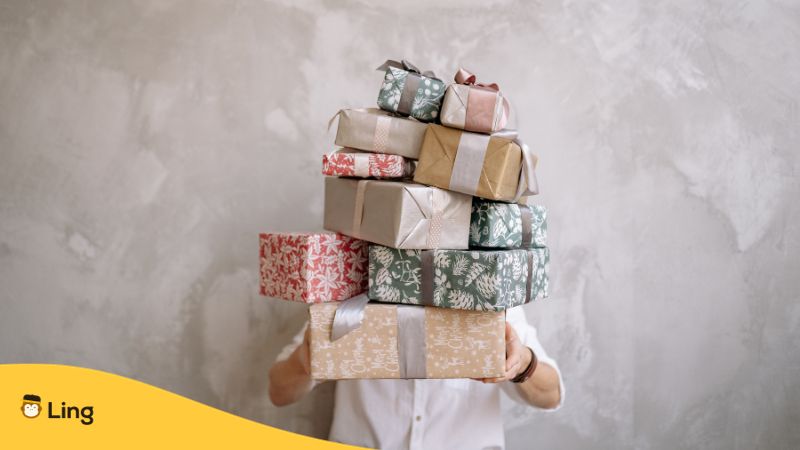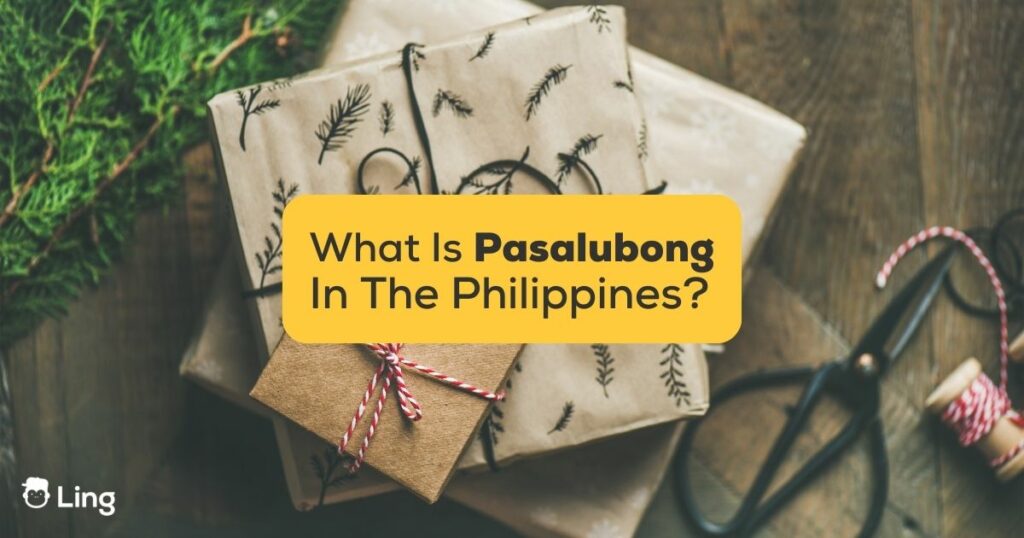I don’t have to tell you this, but it doesn’t take long for travelers to notice how Filipinos just love to give gifts in the form of pasalubong. But wait! What is pasalubong about, and why are the Filipinos going gaga over this tradition? Let’s get to the bottom of it in this guide!
Now if pasalubong is totally new for you (no worries!), here’s the deal in a nutshell. It basically comes from the warm culture of welcoming back friends and family after trips away. So this custom involves surprising them with local goodies packed in your bag to show that – hey! – you missed them and thought of them out there on your journeys. Pretty thoughtful, eh?
It’s pretty much like the Japanese omiyage concept. But to me, there’s something so beautifully Filipino about going above and beyond by rummaging in unfamiliar markets and stores to find THE perfect treat that a certain cousin or co-worker will flip for. You can just see the care and excitement to connect pouring out! Doesn’t a hand-woven Ilocos bag or packet of sweet dried mangoes perfectly express that, hey, relationships matter most to us at the end of the day?
So now that we’re on the same page about pasalubong, want me to give you the real insider lowdown? Join me to learn more about this Tagalog gift-giving concept and the best Tagalog expressions to use. Let’s dive in!
Table of Contents

What Is Pasalubong Culture?
You know, I never fully understood what pasalubong meant until I started learning more about Filipino culture. It translates literally to “to welcome” and “to bring” – which refers to the wonderful tradition of bringing home gifts when you travel or visit relatives. More than just regular souvenirs, these pasalubong gifts are a thoughtful way to reconnect with loved ones after being apart.
I think that comes from the Filipino spirit of showing care, gratitude, and hospitality to our inner circles. We’re pretty much wired to want to make those we love feel included, even from afar! Like when family members work overseas, I’ve noticed my Filipina friends say their parents always try to bring a little something from their country back home. Almost to give their families a small taste of having been to a new place too.
Over time, arriving with these little tokens has become an integral part of coming back to one’s hometown or attending gatherings. Can you believe some relatives feel actual dismay if you show up empty-handed? Of course, gifts don’t have to be expensive – it’s just that personal touch of picking up a snack or accessory that reminds you of someone that matters most. It’s all part of how warm Filipino culture welcomes every homecoming!
Who Gives Pasalubong?
You know, practically everyone brings home some pasalubong when they’ve been away and are coming back to visit family and friends again. But there’s certain groups you can count on to always show up with the most special souvenirs.
Family Members
Let’s take family members headed to celebrations in their home province, for example. Like when it’s Christmas or the town fiesta, aunts and grandparents pack their bags full of treats from Manila and goodies from abroad for all the relatives.
OFWs (Overseas Filipino Workers)
When they finally get a chance to come home after being abroad as nurses, helpers, or on ships, everyone waits in excitement over what pasalubong they’ll have collected! It’s always designer items and imported chocolates they bring.
Tourists And Expatriates
Even tourists get involved when they make local friends and get invited to gatherings while traveling through different islands. To be good guests, they pick up some region-specific snacks as a small token of appreciation. Shells from the beach or candles make simple but sweet pasalubong.
Business Travelers
Business travelers bringing back durian sweets from Davao, colorful woven blankets from the Cordillera highlands, or purple yam jam from Bohol. Coworkers light up seeing these signature goods from a province they may have never visited before.

When To Give Pasalubong?
Given its deep connection to celebrating returns and strengthening bonds, pasalubong is gifted on emotional occasions or gatherings:
Homecomings
Whenever someone comes back to their home region after working elsewhere in the Philippines or abroad, close family excitedly awaits their arrival with pasalubong in tow. It’s almost expected upon crossing the doorstep of returning overseas workers, seafarers, nurses, etc.
Holidays Or Special Days
Filipino fiestas, like town patron saint days or the holidays of Christmas, New Year, and Easter, means family reunions. Visiting Manila-based family members should arrive bearing pasalubong for their overjoyed aunts, grandparents, and all relatives in the province.
Visiting Homes
Bringing a small token whenever you visit family homes is customary, especially if you have recently been away traveling domestically or internationally. Even short trips to Baguio or Tagaytay call for some peanut brittle, strawberry jam, or peanut kisses for your gracious hosts.
Life Events
Weddings, baptisms, and milestone birthdays or anniversaries also see out-of-town guests arriving with delightful pasalubong, often in pretty gift baskets or bags. These special tokens encapsulate well wishes for the occasion and the relatives you may be meeting after some years.
Office Gifts
Co-workers who travel for work conventions, training, or outreach look forward to receiving regional treats picked up as business pasalubong. It makes for happy deskside sharing upon returning to the office, where presenting bags of food gifts is enthusiastically received by the team. Especially if durian candies are included!
Types Of Pasalubong
The most iconic and beloved form of pasalubong revolves around food gifts. But the creativity and diversity of souvenirs brought back range widely. Some popular options include food, woven goods, home and kitchenware, and accessories.
Food
When it comes to pasalubong, food gifts reign supreme in Filipino culture. No collection of homecoming treats would be complete without an assortment of sweet, savory, and decadent edible delights that relatives eagerly await.
This is because, over time, certain provincial specialties have become signature pasalubong deeply connected to their places of origin. The flavors and craft behind these regional delicacies are sources of deep pride and cultural identity.
| Region/Place | Pasalubong | Price Range |
|---|---|---|
| Bohol | Peanut Kisses | PHP 100 – PHP 200 |
| Baguio | Strawberry Jam | PHP 150 – PHP 300 |
| Cebu | Dried Mangoes | PHP 200 – PHP 400 |
| Pampanga | Turrones de Casoy | PHP 100 – PHP 250 |
| Ilocos | Bagnet | PHP 300 – PHP 600 |
| Davao | Durian Candy | PHP 100 – PHP 200 |
| Batangas | Kapeng Barako | PHP 200 – PHP 400 |
| Vigan | Vigan Longganisa | PHP 250 – PHP 500 |
| Bicol | Pili Nuts | PHP 150 – PHP 300 |
| Zamboanga | Satti and Curacha | PHP 200 – PHP 500 |
Woven Goods
Beyond edibles, pasalubong shopping often involves seeking out specialized woven goods reflecting incredible provincial craftsmanship. Over time, certain textiles and handicrafts have become signature pasalubong connected to different islands and communities.
For example, the Cordillera mountain range is renowned for its intricate Kalinga weave blankets, baskets, and apparel featuring vivid geometric patterns reminiscent of rice terraces. The vibrant natural dye hues and textures of these woven wares make them prized pasalubong.
The tribal weaves of the northern tribes, done on backstrap looms, produce shawls and tapestries displaying subtle earth tones and delicate details. Down south, Mindanao’s colorful malong and pis fabrics woven from abaca fibers and plant extracts create stunning gifts.
If you ask me, this is one of the most common pasalubong that continues to shine because it showcases what the Philippines can do. I mean, think of it…the diversity of fibers, looms, and dyeing techniques across 7,000 islands allows for incredible variety, right? It’s like sourcing unique woven ware directly from weavers captures the essence of regional landscapes within the very threads.
Home And Kitchenware
Beyond wearables and edibles, pasalubong hunting involves sourcing ornamental and practical items for Filipino homes and kitchens. Regional crafts passed down generations shine within these everyday objects transformed into gifts.
In the kitchen, one can present hand-carved coconut scrapers, gentle on soft fruit but strong for grating. Touring Ilocos? The Ilocos region has a selection of clay pots, glazed teapots, and burnay water jugs that add pops of regional character at home.
Self-Care And Accessories
Beyond household goods, pasalubong shopping tempts with pampering self-care finds and wearable accessories distinctly Filipino. When sourced from specific provinces, these gifts capture unique island resources from nature’s bounty.
For example, lustrous white, gold, and pink pearls cultivated in Palawan and the Sulu Sea become stunning accessories like bracelets, necklaces, and earrings. Their subtle sheen evokes island life – diving for oyster treasures, warm waves lapping the shores, and the simple luxury of island living.

How To Give Pasalubong In Tagalog
Tagalog is the basis for the Philippine national language, Filipino. When presenting pasalubong souvenirs to Filipino friends or relatives, using a few Tagalog phrases enhances the gesture, especially for non-Tagalog speakers. It shows sincerity in embracing the culture. Here are some ideas:
“Pinadalhan kita ng munting pasalubong”
This means “I brought you a little pasalubong.” The word munti means small or little, a humble way of downplaying your gift.
“Ito ay maliit na handog para sa iyo”
Translating to “This is a small offering for you,” using handog frames the gift as an act of devotion.
“Bilang paggunita sa aking pagbisita”
Meaning “As a souvenir from my visit,” this phrase directly calls out the pasalubong purpose of remembering your time together.
“Maraming salamat sa mainit na pagtanggap”
Say “Thank you for the warm welcome” when presented with return gifts showing the Filipino kamayan spirit.
Ready To Bring A Pasalubong To Someone?
I don’t know about you, but I found this glimpse into the charming tradition of pasalubong so fascinating! It really shed light for me on why gift-giving holds such deep meaning for Filipinos. But you know what would even be lovelier? Continuing learning some key Tagalog phrases around gift-giving! Trust me… Even just a simple “Salamat po” with a smile can add an extra dash of meaning!
This is why I’m excited about language apps like Ling that make picking up Tagalog feel fun with bite-sized lessons. Before we know it, we’ll impress our Filipino friends by whipping out terms for their favorite treats or expressing thanks beautifully in their language. That’s how we nurture deeper bonds – by understanding meanings often best conveyed through dialects close to one’s roots.
Download the Ling app now to start learning Tagalog!

































































